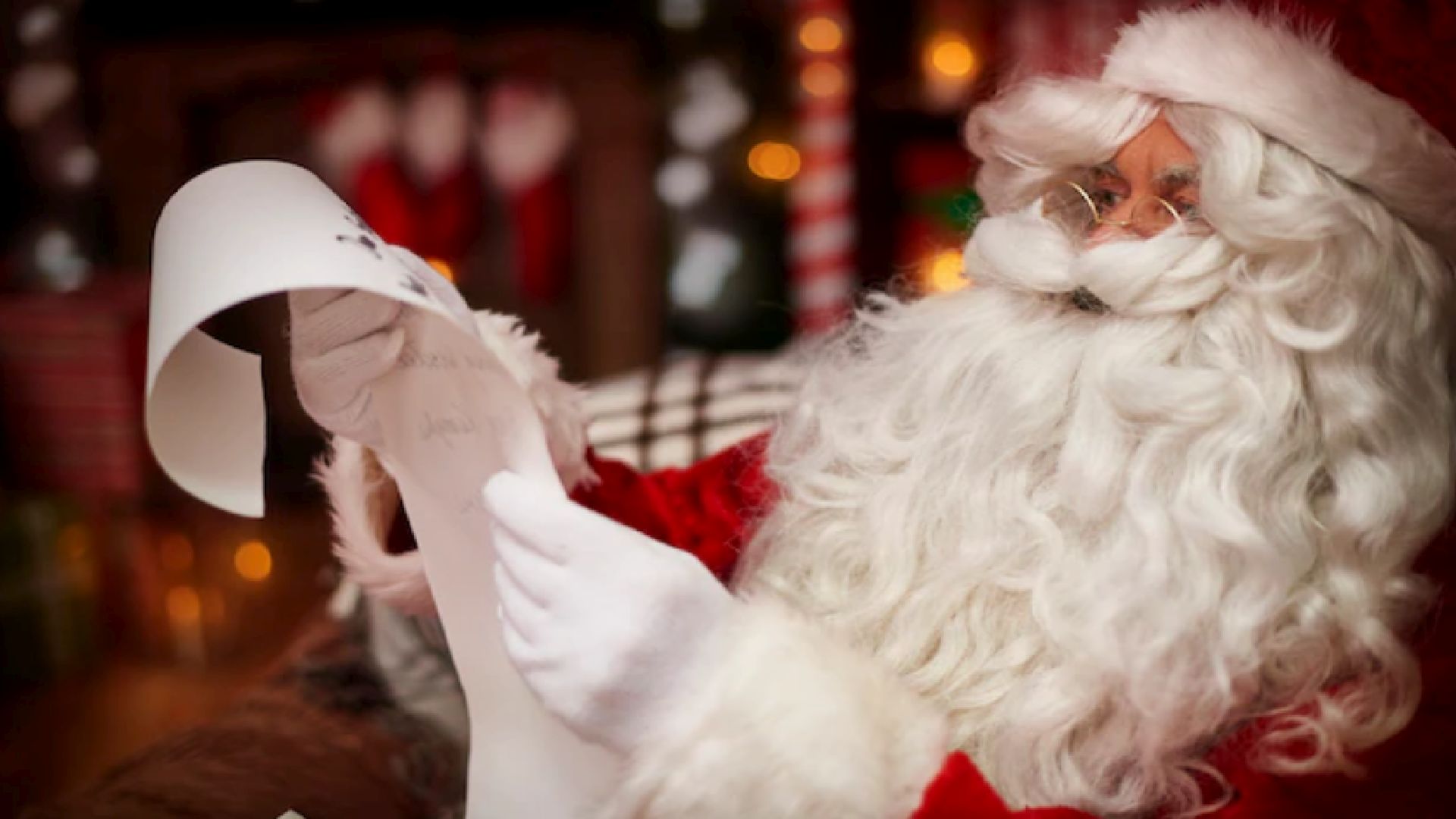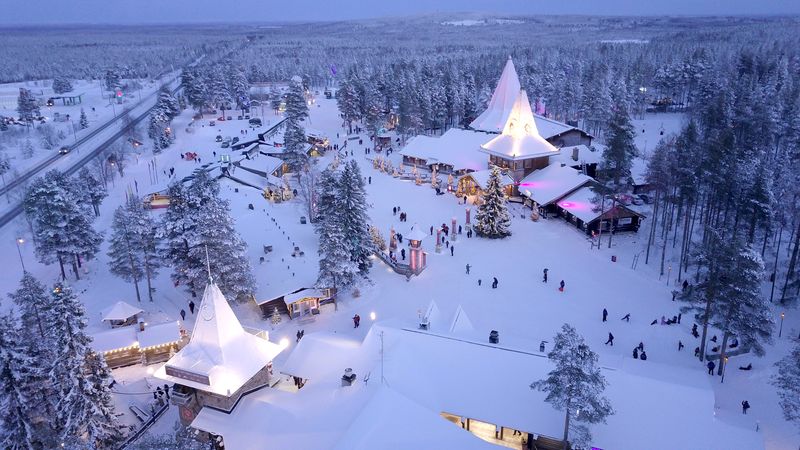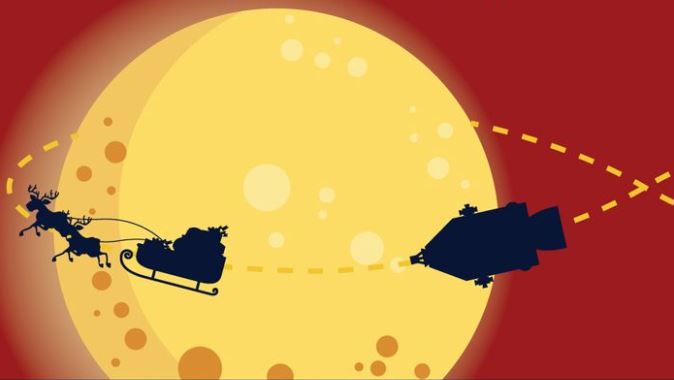
Millions of houses and gifts, and only about 30 hours to visit each one and deliver them. That is the expanse this mythical figure of Christmas has to cover. Mathematicians and scientists analysed the way how Santa Claus achieves this, thanks to numerous calculations.

Santa Claus receives the letters from all the boys before distributing the gifts (Freepik)
At Christmas, magic happens in each house and in the imagination of each child; because, for children around the world, Santa Claus exists. And on this premise, science attempted to answer all the questions that we mortals ask ourselves as we try to reason. Because, after all, we are eager to know more about the work that this bearded man does on his sledge every night on December 24th.
Commanding 8 reindeers, Santa Claus, who is also called Saint Nicholas, manages to distribute millions of gifts throughout the planet. He even manages to arrive at our houses to leave the gifts we wait for so much by the Christmas tree. The same gifts that we asked for in a letter to Santa sent with great enthusiasm, days ago
Thus, what science says, based on facts, is irrefutable. Different researchers searched in mathematics, the physical theories of displacement and even terrestrial rotation, to answer some of these questions that until now had no answer. They have basically concentrated on explaining how Santa Claus distributes all the gifts, all over the world, in one night, to millions of children?

Calculations on the displacement of Santa’s sleigh
In order to continue adding information, the scientists also sought to answer how many letters he receives prior to Christmas Eve, how many hours he has to distribute the gifts, what is his average delivery speed, how much his bag of gifts weigh, how many cookies left by the children Santa gets to eat, why Rudolph the reindeer has a red nose and who were the humans who orbited the earth on December 24 and could have gotten to see him.
In addition to hearing out the voice of international scientists who joined in responding to Santa’s modus operandi, Infobae consulted the mathematician Guillermo Durán, Dean of the Faculty of Sciences of the University of Buenos Aires (UBA), Argentina.
“The problem of how Santa Claus manages to deliver so many presents to millions of houses around the world in a single night is something that mathematics likes to solve. These are historical problems that mathematicians set themselves, which are associated with more mundane and common tasks that must be solved to make some jobs more efficient. One is the traveling salesman problem. There are scientific studies looking at how to distribute merchandise in Germany or Sweden in 20 or 50 cities with more than 10,000 inhabitants and be more efficient and save time. Another problem is that of the postman. What should be the most efficient route for a postman in a city to deliver his letters without walking too far or going the same block again,” explained Durán, who has a degree in Mathematics and a PhD in Computer Science.
Durán said that he had to apply his services as a mathematician to the National Basketball League, which would be like the Argentine Football Association (AFA) but in basketball. It turns out that the games are played every two or three days throughout the country.
“The managers needed to configure the most optimal route for all the participating clubs that is equitable in terms of distances and dates so that basketball can be played without the match dates clashing. That is also done by the NBA in the United States. Being a large territory like Argentina, it is necessary to carry out the pertinent calculations to configure an optimal route”, added the expert who anticipates that for the next Soccer World Cup, to be played in 2026 in the United States, Canada and Mexico, mathematicians will surely contribute their calculations to FIFA.
Regarding Santa Claus, Durán indicated that the calculation that international scientists made to explain his journey and his way of working, is nice. “Of course the results may vary, since you can take hard baseline data that will ultimately change the final equation,” he said.
HOW MANY CHILDREN DOES SANTA CLAUS HAVE TO GIVE GIFTS TO?
Millions of children write to Santa Claus asking for gifts
According to UNICEF, today there are about 2 billion children worldwide. But not everyone believes in Santa Claus, so we must remove those who do not have the tradition and the belief that they will be visited by the man in red. Removing the countries where Christmas is not celebrated, the calculations indicate that there are some 378 million children who will wait for Saint Nicholas. Some figures put it at 900 million, but not all of them live in different houses. So scientists calculate that each home can have up to 3 children. Thus, they reduce to almost 92 million homes those that Santa Claus must visit on that special night. The most ambitious calculations speak of 300 million homes.
Since earth has about 25 million square miles (65 million square kilometers) of habitable land, the average distance between two homes is about 0.138 miles (0.225 km).
HOW MUCH TIME DOES SANTA CLAUS HAVE TO DO HIS JOB?
Due to rotation of the earth, Christmas Eve begins at different times, depending on where we are in the world. The first place on earth where Christmas Eve begins is in Kiribati, a country made up of many islands in the Pacific Ocean. Its easternmost islands are 14 hours ahead of Coordinated Universal Time (UTC), on the border of the International Date Line.

The magic of Christmas can also count on some science, especially when it comes to the work of Santa Claus / (Reuters)
Santa at least has the advantage of being close to the winter solstice, which gives him some extra time in the northern hemisphere. Due to time zone difference, the international date line, and variations in the sunset and sunrise times between locations and latitudes, Santa ends up with a maximum of 31 hours to reach those 300 million households. In that short time, he has to perform the following tasks:
- Travel to each house, an average distance of 0.33 kilometers from the previous house.
- Get off his sleigh and enter the house without being detected (he prefers to enter through the chimneys).
- Deliver all the gifts.
- Eat any cookie that the children have left for him and, make his reindeer eat grass too.
- Leave the house without being detected, get on the sleigh and visit the next house.

How many homes must Santa visit in one night? (Pexels)
Mathematics PhD Katy Sheen from the University of Exeter, UK, used Albert Einstein’s theory of relativity and Christian Andreas Doppler’s Doppler effect to help explain Santa’s motion. She calculated that Santa Claus must visit about 700 million children in 31 hours — according to different time zones — this implies that Santa and his reindeers advance at 10 million kilometers per hour.
But taking into account the breaks he takes to eat cookies with milk or feed his animals, this speed would increase even more. This is where relativity does its wonder. Traveling so fast, Santa Claus, his reindeers, the sleigh, and the presents he carries – all contract as time stretches making bodies shrink according to the direction they travel. This allows Santa to enter every house with a bag of gifts through its narrowest of chimneys
HOW DO YOU MAKE IT SO THAT NO ONE SEES OR HEARS YOU?
Thanks to the Doppler effect, which is a change in the apparent frequency of a wave produced by the relative movement of the source with respect to its observer, the mythical Christmas character and all his equipments appear bluer when they get closer and redder as they recede. This happens so quickly that the wavelength of light becomes shorter and shorter, until they are practically invisible to the human eye.
In addition, the sleigh bells and the “ho ho ho” initially appears to he heard as the frequency of sound rises higher and higher like an approaching ambulance siren, until it reaches a point where it gradually ceases to be heard, as Santa leaves, making it ultimately imperceptible to humans.

File image of an aerial view of Santa Claus Village on the Arctic Circle, near Rovaniemi, Finland. Image taken with a drone. REUTERS/Attila Cser/File
The reason why Santa Clause manages to move at such a high speed of 10 million kilometers per hour is extremely difficult to find. So in that case it could be a “little bit of magic”, according to Dr. Sheen, who does not plan to present her research to a peer-reviewed journal and has done the calculations in her spare time just to interest children in science and physics, and answer questions she has been asking herself since she was 7 years old, according to a statement from the University of Exeter.
300 MILLION HOMES IN 24 HOURS?
Santa just has to keep up and allot no more than a quarter of a millisecond per household. That’s more than 1,000 times faster than the blink of an eye. There are 63.7 million square kms of inhabited earth on the planet, which gives an average stop to enter a chimney – or window – every 0.067 square kms. Doing quick calculations, on average, the sledge is moving at almost 3000 kms per second. At that speed traveling from Buenos Aires to Ushuaia would take a second.
To move that average distance of 0.33 km from house to house, assuming a time of 150 microseconds (which is half the total time he is allowed in each house), Santa only needs to travel at around 3000 kilometers per second. Sure, that may seem insanely fast compared to a typical sledge, or even a typical supersonic car, train, or plane. But that’s 1 per cent of the speed of light and much slower than the particles emitted by radioactive atoms, particle accelerators, or even the Sun.
 Santa Claus records a sequence with Storyfile in Los Angeles, before getting on his sleigh. REUTERS/ReutersTV
Santa Claus records a sequence with Storyfile in Los Angeles, before getting on his sleigh. REUTERS/ReutersTV
ACCELERATION OF THE SLEDGE
Experts say, while travelling, there’s no way to open the sleigh, with Santa inside, due to the heat or acceleration generated at that speed. Moving at such intense speed, the frictional forces of the atmosphere alone could spell disaster; the only things we are familiar with colliding with the atmosphere at that speed are meteors and satellites re-entering the atmosphere.
Santa would need to dissipate somewhere in the order of a few trillion joules of heat per second of travel, which is a tremendous amount. Without any protection, you would expect Santa Claus, flying through the atmosphere at the speed of a meteor shower, to burn up like a satellite does during re-entry. That is why it is worth asking, what material is the red suit made of so as not to become flammable due to the friction of the air when traveling at such speed? Or, where does it get the energy or fuel to travel so fast? There are two explanations:
- He could have a heat shield that would protect both the reindeers and himself, allowing him to travel freely. This is a problem, however, if we are considering an open sledge, which by definition will not leave the rider protected. But the second option could beat even this.
- You could have a vehicle so aerodynamically advanced that most of the air in front of it is evacuated, leaving only a light breeze.

Santa Claus in an image generated in France
Santa, to reach his average speed when traveling from house to house, requires 1.5 billion g/s. The man experiences 27g/s of force, where 1g is the acceleration due to the gravity. Even if we consider that most of the world’s population is concentrated in urban areas, the acceleration and deceleration during the journey from chimney to chimney would be catastrophic in this short time interval. The short-time human endurance record is 83 g/s, set by Commander John Beeding in a rocket. The idea that humans could withstand these incredible accelerations/decelerations was pioneered by John Stapp, who tested his devices in the 1940s and 1950s.
Scientists explain that an enormous amount of energy, and therefore fuel, is needed to pull a sleigh full of gifts to 500 million homes around the world. So how much energy does it really take to carry these gifts around the world?
Assuming Santa has about 2 kilograms of presents to deliver to each house, that adds up to about a million metric tons of presents in his fully loaded sleigh (it gets lighter as the night wears on). This is approximately 4,000 times the payload capacity of the largest aircraft on Earth: the Antonov AN-225.
The scroll of Santa Claus taken by Apollo 8
There was a spacecraft between the Earth and the Moon in 1968 that could have seen Santa’s work from space. It was the Apollo 8 mission, the first manned spacecraft to leave low Earth orbit. The following exchange between Ken Mattingly (at mission control in Houston) and Jim Lovell (aboard Apollo 8) 50 years ago leaves no doubt of that historic moment:
089:33:38 Mattingly: Apollo 8, Houston.
089:34:16 Lovell: Houston, Apollo 8, over.
089:34:19 Mattingly: Hello, Apollo 8. Loud and clear.
089:34:25 Lovell: Roger. Note that there is a Santa Claus.
089:34:31 Mattingly: That is affirmative. You guys are the best to know.
This is another proof that Santa Claus exists, and that in addition to many scientific calculations, he surely possesses an inexplicable magic that makes it possible for each child to have a present at Christmas.
This article was originally published in Infobae in Spanish.

